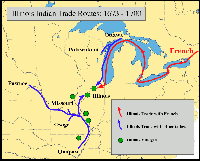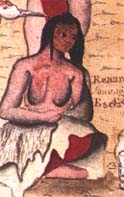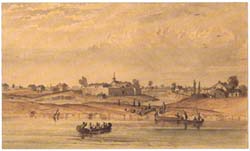
 |
The Ilinois are warriors and take a great many Slaves, whom they trade with the Outaouaks [Ottawa] for Muskets, Powder, Kettles, Hatchets and Knives. (Jacques Marquette, 1669) Map of Illinois Indian trade routes: 1673-1700 enlarge |
In the late 1600s, the Illinois served as middlemen in an extensive trading network. They received hides and furs from the Osage and Missouri tribes living to their south and west, which they exchanged with the Ottawa and other Great Lakes tribes for guns, brass kettles, tools, and other objects manufactured by whites living in Canada and Europe. The Illinois also carried on a special trading relationship with the Potawatomi and Ottawa tribes. From these tribes they obtained porcupine quills--not available in their own territory--which they used to decorate their moccasins.
![]()
A female slave affiliated with the "Renard" (Fox or Mesquakie) tribe, who accompanied Illinois Indians on a visit to New Orleans. (colored pen and ink by Alexandre de Batz, 1735)
The Illinois also participated in a Native American slave-trade network. When Illinois warriors captured slaves during raids on the Pawnee and other tribes living in the central Great Plains, they traded some of them to the Ottawa and other Great Lakes tribes for European goods. In the late 1600s, a slave could be exchanged for the equivalent of about 100 francs. Some slaves were adopted by Indian families to replace family members who had died. Other slaves became the property of Europeans living in Canada or in the Illinois Country. For example, in the 1680s a French explorer and fur trader named Rene-Robert Cavelier, Sieur de La Salle, kept several slaves given to him by the Michigamea tribe. One was a woman who had bee captured from the Panneassa (Pawnee) tribe; another was a teenage boy who had been captured from the Pana (Wichita?) tribe.
![]()
Chicago and old Fort Dearborn in 1820. (watercolor by Seth Eastman, based on an 1820 sketch by H. R. Schoolcraft)
The Illinois traded directly with French traders, first at trading posts located on the Great Lakes and later at posts established by the French near the Illinois' villages. The Illinois bartered for a variety of European trade goods, including cloth, blankets, knives, vermilion, brass kettles, silver ornaments, guns, gunpowder, gun flints, lead, glass beads, and liquor.![]()
|
|
Copyright © 2000 Illinois State Museum

